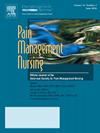Case Study: Medication Diversion Through Intravenous Patient Controlled Analgesia (IV PCA) Manipulationion
IF 1.6
4区 医学
Q2 NURSING
引用次数: 0
Abstract
The diversion of opioid medications is a concern in the hospital setting. The main focus of diversion in institutions is healthcare providers diverting medications. There are instances in the literature of nurses who have diverted Intravenous Patient Controlled Analgesia medications and reinstated the removed volume with saline infected with bacteria. These cases were investigated because a cluster of patients with bacteremia occurred.
Patient diversions have been documented as case reports primarily. The manipulations have occurred with opening the lock box with a paper clip or opening if the lock box was loaded incorrectly
reported diversions occurring from manipulating the programming of the pump or stealing the IVPCA key
The purpose of this case study was to determine how a patient could divert medication from an IV PCA using the simulation lab arm. The arm is pressurized to simulate blood flow using red colored solution and green food dye colored the IVPCA fluid.
The second trial provided a mechanism to obtain more medication from the system when the needled syringe was placed proximal to the IVPCA machine. The opioid medication was siphoned after the Patient Controlled Analgesia button was pressed and pulling back of the plunger of the syringe while administering the bolus. The patient was able to divert 2ml (2mg) from the tubing and administer instead of the .2mg with each PCA bolus dose. A small pin hole in the tubing was the only indication medication was removed in a manner other than PCA bolus dose.
Diversion of medications in the hospital is a concern for patient safety. Patients manipulating programming of pumps or compromising the closed IVPCA system physically needs to be prevented. The hope of this clinical presentation is to provide clinicians with the knowledge of this possible medication diversion method in the hospital setting.
求助全文
约1分钟内获得全文
求助全文
来源期刊

Pain Management Nursing
医学-护理
CiteScore
3.00
自引率
5.90%
发文量
187
审稿时长
>12 weeks
期刊介绍:
This peer-reviewed journal offers a unique focus on the realm of pain management as it applies to nursing. Original and review articles from experts in the field offer key insights in the areas of clinical practice, advocacy, education, administration, and research. Additional features include practice guidelines and pharmacology updates.
 求助内容:
求助内容: 应助结果提醒方式:
应助结果提醒方式:


